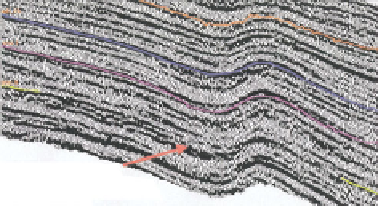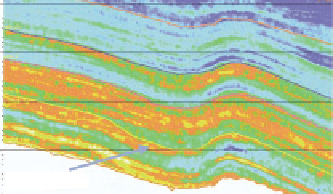Geology Reference
In-Depth Information
Seismic trace inversion
Chapter
9
9.1 Introduction
Seismic trace inversion reduces the effect of the
wavelet by replacing the seismic with blocks of
impedance at a particular time sampling interval
(e.g. 4 ms) and their arrangement gives an indication
of acoustic layering in the subsurface (
Fig. 9.1
).
Inverted data can be useful to the interpreter in a
number of ways, including simplifying stratigraphic
relationships and making lithological and fluid
related effects more interpretable. An additional
benefit is that the results of inversions are more
readily appreciated by workers in the non-geophysics
disciplines, such as geology and engineering, as the
data is presented in recognisable layers.
Inversions to absolute impedance rely on well data
for their parameterisation and so they are typically
(although not exclusively) carried out in reservoir
appraisal and development situations. Insight into
the reservoir is gained through combining inversion
results with rock physics, geological and petrophysical
models, and so inversion results can be directly rele-
vant to the creation of geomodels for reservoir
simulation.
In general there are two types of inversion, deter-
ministic and stochastic. Deterministic inversions are
relatively straightforward to generate and are based
on the minimisation of the difference between a mod-
elled seismic trace and the actual seismic trace. As
such, these types of inversions are smoothed solu-
tions, representing a best estimate within the limits
imposed by the bandwidth of the data. This effectively
means that in areas where the geology is layered on a
scale less than about 1/4 of the seismic wavelength the
resulting inversion is likely to be inappropriate for
quantitative interpretation. Unfortunately, this scale
is important in most reservoirs.
The non-uniqueness of the sub-tuning component
in seismic can be addressed through geostatistical
inversion, which uses geostatistics to generate mul-
tiple impedance realisations, at the reservoir model
scale. Each realisation matches the seismic trace,
honours the statistics of property variation between
well datapoints and ties the wells exactly. Realisations
can be transformed to reservoir properties (using
rock physics relationships and various mapping
algorithms) and the results can be analysed in terms
of uncertainty as well as connectivity. These types
of stochastic inversion products are invaluable for
conditioning geomodels in reservoir development
but there is usually a significant cost in time and
money to produce them.
a)
Reflectivity
0.4
0.5
0.6
Is this just a sag in
the seismic or is
the interpretation
more complex?
b)
Acoustic Impedance
AI
High
0.4
0.5
0.6
Incised
channel
Figure 9.1
A reflectivity section and its acoustic impedance
inversion equivalent (after Latimer et al.,
2000
).
Low
198





